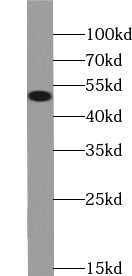Products
SIRT6 antibody
| Synonyms: | NAD-dependent protein deacylase sirtuin-6|NAD-dependent protein deacetylase sirtuin-6|Protein mono-ADP-ribosyltransferase sirtuin-6|Regulatory protein SIR2 homolog 6 (hSIRT6)|SIR2-like protein 6|SIRT6|SIR2L6 antibody | ||
| Catalogue No.: | FNab07884 | Reactivity: | Human, Mouse, Rat |
| Host: | Rabbit | Tested Application: | ELISA, WB, IHC |
| Clonality: | polyclonal | Isotype: | IgG |
| Size | Price |
|---|---|
| 100µg | Inquiry |
- SPECIFICATIONS
- CITATIONS
- FIGURES
- CONDITIONS
- FAQS
- Product Name
- SIRT6 antibody
- Catalogue No.
- FNab07884
- Size
- 100μg
- Form
- liquid
- Purification
- Immunogen affinity purified
- Purity
- ≥95% as determined by SDS-PAGE
- Clonality
- polyclonal
- Isotype
- IgG
- Storage
- PBS with 0.02% sodium azide and 50% glycerol pH 7.3, -20℃ for 12 months(Avoid repeated freeze / thaw cycles.)
- Immunogen
- sirtuin(silent mating type information regulation 2 homolog) 6
- Alternative Names
- NAD-dependent protein deacylase sirtuin-6|NAD-dependent protein deacetylase sirtuin-6|Protein mono-ADP-ribosyltransferase sirtuin-6|Regulatory protein SIR2 homolog 6 (hSIRT6)|SIR2-like protein 6|SIRT6|SIR2L6 antibody
- UniProt ID
- Q8N6T7
- Observed MW
- 49 kDa
- Tested Applications
- ELISA, WB, IHC
- Recommended dilution
- WB: 1:200-1:2000; IHC: 1:50-1:200
 HeLa cells were subjected to SDS PAGE followed by western blot with FNab07884(SIRT6 antibody) at dilution of 1:400
HeLa cells were subjected to SDS PAGE followed by western blot with FNab07884(SIRT6 antibody) at dilution of 1:400
 Immunohistochemistry of paraffin-embedded human brain using FNab07884(SIRT6 antibody) at dilution of 1:50
Immunohistochemistry of paraffin-embedded human brain using FNab07884(SIRT6 antibody) at dilution of 1:50
- Background
- NAD-dependent protein deacetylase. Has deacetylase activity towards histone H3K9Ac and H3K56Ac. Modulates acetylation of histone H3 in telomeric chromatin during the S-phase of the cell cycle. Deacetylates histone H3K9Ac at NF-kappa-B target promoters and may down-regulate the expression of a subset of NF-kappa-B target genes. Acts as a corepressor of the transcription factor HIF1A to control the expression of multiple glycolytic genes to regulate glucose homeostasis. Required for genomic stability. Regulates the production of TNF protein. Has a role in the regulation of life span(By similarity). Deacetylation of nucleosomes interferes with RELA binding to target DNA. May be required for the association of WRN with telomeres during S-phase and for normal telomere maintenance. Required for genomic stability. Required for normal IGF1 serum levels and normal glucose homeostasis. Modulates cellular senescence and apoptosis. On DNA damage, promotes DNA end resection via deacetylation of RBBP8. Has very weak deacetylase activity and can bind NAD(+) in the absence of acetylated substrate.
- Journal:
- Food & Function
- Cited Date:
- 2021-08-27
- Product:
How many times can antibodies be recycled?
First, usually it's not suggested to recycle antibodies. After use, buffer system of antibodies has changed. The storage condition of recycled antibodies for different customers also varies. Thus, the performance efficiency of recycled antibodies can’t be guaranteed. Besides, FineTest ever conducted the antibody recycling assay. Assay results show recycling times of different antibodies also varies. Usually, higher antibody titer allows more repeated use. Customers can determine based on experimental requirements.
Notes: After incubation, we recycle rest antibodies to centrifuge tube and store at 4℃. High titer antibodies can be stored for a minimum of one week. Reuse about three times.
What are components of FineTest antibody buffer?
Components of FineTest antibody buffer are usually PBS with proclin300 or sodium azide, BSA, 50% glycerol. Common preservative is proclin300 or sodium azide, which is widely applied in the lab and industry.
How about the storage temperature and duration of FineTest antibodies?
Most antibodies are stored at -20℃. Directly-labeled flow cytometry antibodies should be stored at 2 - 8℃. The shelf life is one year. If after sales issues for purchased antibodies appear, return or replacement is available. Usually, antibodies can be still used after the one-year warranty. We can offer technical support services.
Is dilution required for FineTest antibodies? What’s the dilute solution?
Directly-labeled flow cytometry antibodies are ready-to-use without dilution. Other antibodies are usually concentrated. Follow the dilution ratio suggested in the manual. Dilute solution for different experiments also varies. Common antibody dilution buffers are acceptable(e.g. PBST, TBST, antibody blocking buffer).
How to retrieve antibodies for immunohistochemistry?
Common retrieval buffers: Tris-EDTA Buffer(pH 9.0); Citrate Buffer(pH 6.0)
Heat induced antibody retrieval:
Method 1: Water-bath heating: Put the beaker with retrieval buffer and slide in the boiling water bath. Keep the boiling state for 15min. Naturally cool to room temperature;
Method 2: Microwave retrieval: Put the beaker with retrieval buffer and slide in the microwave oven. Heat at high power for 5min, Switch OFF for 3min, Heat at medium power for 5min. Naturally cool to room temperature.
How to choose secondary antibodies?
(1) Secondary antibodies react with primary antibodies. Thus, secondary antibodies should be against host species of primary antibodies. E.g. If the primary antibody is derived from rabbit, the relevant secondary antibody should be against rabbit. E.g. goat anti rabbit or donkey anti rabbit.
(2) Choose secondary antibody conjugates according to the experimental type, e.g. ELISA, WB, IHC etc. Common enzyme conjugated secondary antibodies are labelled by HRP, AP etc. Fluorescin or dye labelled secondary antibodies are applied in immunofluorescence and flow cytometry(e.g. FITC, Cy3).
